Catskill Mountains facts for kids
Quick facts for kids Catskill Mountains |
|
|---|---|
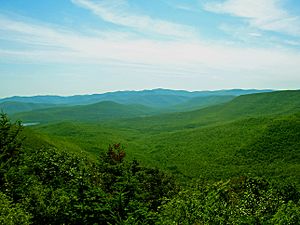
Slide Mountain and nearby peaks as seen from Twin Mountain in the northern Catskills
|
|
| Highest point | |
| Peak | Slide Mountain |
| Elevation | 4,180 ft (1,270 m) |
| Dimensions | |
| Length | 111 mi (179 km) N/S |
| Width | 102 mi (164 km) E/W |
| Area | 15,259 km2 (5,892 sq mi) |
| Geography | |
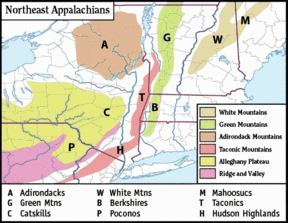
Main regions of the northeast Appalachians, with the Catskills as "C"
|
|
| Country | United States |
| Communities | Ellenville, Fleischmanns, Hunter, Liberty, Margaretville, Hancock, New York, Palenville and Phoenicia |
| Parent range | Appalachian (Allegheny Plateau) |
| Geology | |
| Age of rock | Devonian and Mississippian |
| Type of rock | Sedimentary |
The Catskill Mountains, also known as the Catskills, are a beautiful mountain area in southeastern New York. They are part of the larger Appalachian Mountains. The Catskills are a special place because much of the land is protected as part of the Catskill Park. This park covers about 700,000 acres (2,800 km²) and helps keep the area wild and natural.
Even though they are called "mountains," the Catskills are actually a "dissected plateau." This means they started as a flat area that was later lifted up. Over millions of years, rivers and glaciers carved deep valleys and sharp peaks into it. The Catskills are famous in American culture. They have been featured in many paintings and movies. For a long time, they were a popular vacation spot for people from New York City. Many famous comedians even started their careers performing at resorts here! Today, the Catskills are still a favorite place for artists, musicians, and writers.
Contents
- What's in a Name? The Catskills' Story
- Exploring the Catskills: Geography
- Catskills Weather: A Quick Look
- How the Catskills Were Formed: Geology Basics
- Fun Things to Do in the Catskills: Recreation
- Cool Structures in the Catskills
- Getting Around the Catskills: Transportation
- The Catskills in Books, Movies, and Music
- Images for kids
- See also
What's in a Name? The Catskills' Story
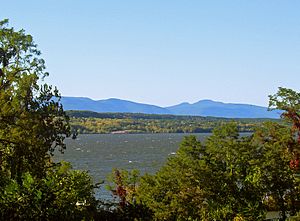
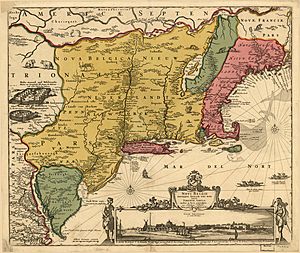
The name "Catskill" comes from early Dutch settlers. On a 1656 map, the area was called Landt van Kats Kill. In Dutch, "kill" means "creek" or "river." So, "Catskill" means "cat creek."
No one is completely sure why it was named this. One idea is that there were mountain lions (also called catamounts) in the area when the Dutch arrived.
Over time, people spelled the name differently, like Kaatskill and Kaaterskill. You can still see these spellings today, like in the name of a regional magazine or a famous waterfall. There's also a made-up Native American name, Onteora, which means "land in the sky." This name was created in the 1800s to attract tourists. It is still used for a school district and a Boy Scout camp.
Exploring the Catskills: Geography
The Catskill Mountains are about 100 miles (160 km) northwest of New York City. They are also about 40 miles (64 km) southwest of Albany. The mountains cover most of two counties: Greene and Ulster. They also reach into Delaware, Sullivan, and Schoharie counties.
On the eastern side, the mountains rise sharply from the Hudson Valley. This steep edge is called the Catskill Escarpment. On the western side, the mountains slowly get lower and blend into the rest of the Allegheny Plateau. The Pocono Mountains in Pennsylvania are also part of this same plateau.
The Catskills have more than 30 peaks that are taller than 3,500 feet (1,067 meters). They also have parts of six important rivers. The highest mountain is Slide Mountain in Ulster County, which is 4,180 feet (1,274 meters) tall. There's even a club, the Catskill Mountain 3500 Club, for people who have climbed all the tallest peaks!
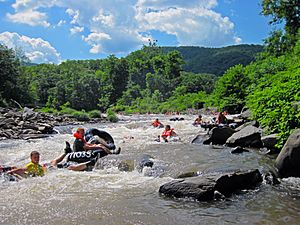
Catskills Weather: A Quick Look
The Catskills have a climate with warm summers. This means summers are warm and humid, and winters are cold with snow. The weather changes quite a bit from the lower valleys to the higher mountain peaks. For example, the top of Slide Mountain is much colder than towns in the valleys.
How the Catskills Were Formed: Geology Basics
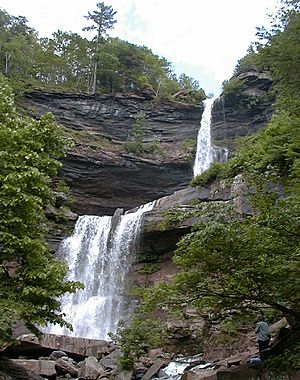
The Catskill Mountains are not like the Adirondack Mountains to the north. The Adirondacks are much older and formed differently. The Catskills are a "dissected plateau." This means they were once a flat area that was later lifted up and then carved by water and ice.
The rocks in the Catskills were formed from sand and gravel. This material came from ancient mountains to the east, called the Acadian Mountains. Rivers carried these sediments westward, forming a huge delta into a sea that used to be here. Over millions of years, these sediments piled up and turned into solid rock.
Later, the entire area was lifted up. This caused the rocks to start eroding. Over time, much of the rock has worn away, leaving the mountains we see today. In the past, huge sheets of ice called glaciers also helped shape the Catskills. They widened valleys and rounded the mountain tops. Even today, rivers and streams continue to carve the valleys deeper.
Fun Things to Do in the Catskills: Recreation
The Catskills are a great place for outdoor adventures and relaxation!
The Borscht Belt: A Look Back
In the middle of the 20th century, the Catskills were a very popular vacation spot, especially for Jewish New Yorkers. Many large resorts, nicknamed the "Borscht Belt," offered entertainment and activities. At one point, there were about 500 resorts! While most of these resorts are gone, some communities and camps still serve Orthodox Jewish families today.
Water Sports and Fun
The Esopus Creek is a 65.4-mile (105.3 km) long river that flows into the Hudson River. It's famous for tubing, where people float down the river in inner tubes. Many people start their tubing trip in Phoenicia, New York.
The Ashokan Reservoir is a large lake that is part of New York City's water supply. You can fish there with a permit, but swimming is not allowed. Canoeing and kayaking are also popular on the rivers, with different levels of rapids for all skill levels. The Esopus Creek is also well-known for fly fishing.
Biking Adventures
Both road biking and mountain biking are popular here. There's a big bike race called the Tour of the Catskills every summer. You can also find trails like the Catskill Scenic Trail and the Headwaters Trails. Some ski resorts even offer downhill mountain biking in the warmer months.
Hiking and Camping
The Catskill Park covers over 700,000 acres (2,800 km²). It's part of New York's Forest Preserve, which means much of it is protected land. Many trails are kept in good shape by groups like the New York–New Jersey Trail Conference. The Devil's Path is one of the many challenging trails for hikers. If you like camping, you can find great spots at places like Bear Spring Mountain and North-South Lake.
Skiing and Snowboarding
When winter arrives, the Catskills become a snowy playground! There are five main places to ski and snowboard:
- Belleayre Mountain
- Hunter Mountain (which was the first to use snowmaking machines in New York!)
- Windham Mountain
- Holiday Mountain Ski and Fun
- Plattekill Mountain
There's also a cross-country skiing center in Tannersville with 22 miles (35 km) of trails.
Cool Structures in the Catskills
Fire Towers: Watching Over the Forests
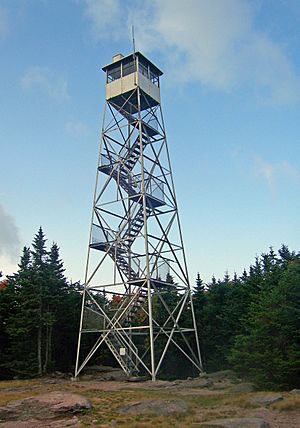
Long ago, fire towers were built in the Catskills to help spot forest fires. Between 1908 and 1950, 23 towers were built. By the 1970s, airplanes became better at spotting fires, so the towers were no longer used. Most were taken down, but six have been fixed up and are now open to the public. You can climb them for amazing views!
The towers you can visit are:
- Balsam Lake Mountain Fire Observation Station (3,723 ft / 1,135 m)
- Hunter Mountain Fire Tower (4,042 ft / 1,232 m)
- Mt. Utsayantha Fire Tower (3,214 ft / 980 m)
- Overlook Mountain Tower (3,140 ft / 957 m)
- Red Hill Fire Observation Station (2,990 ft / 911 m)
- Mount Tremper Fire Observation Station (2,740 ft / 835 m)
Famous Landmarks
The Catskill Mountain House was a famous hotel built in 1824. It was located near Palenville, New York, with beautiful views of the Hudson River Valley. Many important people, including U.S. Presidents, stayed there.
Getting Around the Catskills: Transportation
In the past, trains were a big way to get around the Catskills. Several railroads served the area, bringing people and goods. Passenger train service ended in the 1950s.
Today, you can still experience some of the old train routes! The Delaware and Ulster Railroad and the Catskill Mountain Railroad are "heritage railroads." This means they run old trains for tourists to enjoy scenic rides.
Most people travel to the Catskills by car. Major highways like Interstate 87 (the New York State Thruway) make it easy to get there from the east. Other routes like U.S. Route 209 and New York State Route 17 provide access from the south and southwest. Roads like 28 and 23A cut right through the heart of the mountains, leading to popular tourist spots.
There are also several smaller airports in and around the Catskills. The closest major airports are Albany International Airport to the north and Stewart International Airport to the south.
The Catskills in Books, Movies, and Music
The Catskills have inspired many stories and works of art!
- The famous short story Rip Van Winkle is set here.
- The children's book My Side of the Mountain also takes place in the Catskills.
- Many films have been set in the Catskills region.
The town of Bethel, New York, in the Catskills, was the home of the legendary Woodstock music festival. This huge event happened in August 1969, with 32 music acts performing for over 500,000 people! A documentary movie called Woodstock (1970) captured the event. Today, the site is home to the Bethel Woods Center for the Arts.
The many hotels and resorts in the Catskills also played a big role in the history of modern stand-up comedy. Famous comedians like Rodney Dangerfield and Don Rickles started their careers performing at these "Borscht Belt" hotels.
Images for kids
-
The Catskills, 1859 painting by Asher Brown Durand depicting the Catskills using the "sublime landscape" approach
-
The Redmond Stage, Woodstock music festival, 1969
See also
 In Spanish: Montañas de Catskill para niños
In Spanish: Montañas de Catskill para niños








